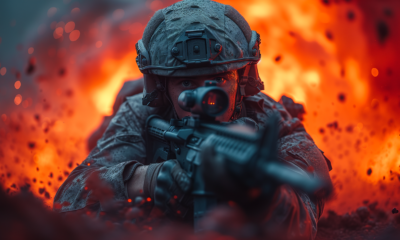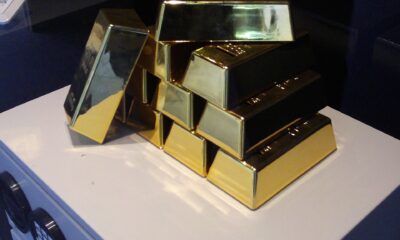Contributors to the text Gold’s Muted Response Speaks Volumes: Joe Foster, Portfolio Manager and Strategist, and Imaru Casanova, Deputy Portfolio Manager/Senior Analyst for the Gold Strategy
Gold Faced Selling Pressure Early in February Despite Normally Positive Conditions
In an environment that would typically be positive for gold, it appears gold faced selling pressure as investors searched for liquidity to cover margin calls and redemptions. Gold declined in February as increased market volatility and a drop in equity and bond markets failed to support demand for gold as a safe haven1. On February 2, the labor market report in the U.S. showed a strong rebound in average hourly earnings that was well above expectations. The U.S. dollar rallied and gold declined. Equity markets dropped, with the Dow Jones Industrial Average (DJIA)2 down almost 9% by February 8 (ending February down 4%), U.S. Treasury yields rose, and the U.S. dollar, rather than gold, was the beneficiary.
Weaker U.S. Dollar, Heightened Inflation Expectations Helped Gold Reach Month High
On February 14, January’s inflation report beat consensus, with headline inflation measured by the Consumer Price Index (CPI)3 accelerating to 2.1% year-on-year. U.S. Treasury yields continued their rise and the U.S. dollar weakened. Meanwhile, the equity markets and gold bounced back. Gold reached its high for the month of $1,353.70 per ounce on February 15.
Gold Rally Loses Momentum as U.S. Dollar Strengthens on Fed comments
However, the gold rally was short lived, as the markets priced in hawkish expectations ahead of the release of Federal Open Market Committee (FOMC) minutes on February 21. The Fed minutes themselves did not contain much new information, but confirmed the market’s expectations for three rate hikes this year. In addition, the testimony by new Fed chairman Jerome Powell to the House of Representatives’ Committee on Financial Services was viewed as optimistic, stating that he sees gradual rate hikes, and more importantly, an improved U.S. growth outlook. The U.S. Dollar Index (DXY)4 was up 1.7% during the month. Commodities were lower during February, which is also negative for gold. Gold closed at $1,318.38 per ounce on February 28, down 2% or $26.78 per ounce for the month.
Demand for Gold ETPs up YTD Helping Bullion Outperform Gold Stocks
Demand for gold bullion-backed exchange traded products (ETPs) declined in February, with holdings down about 0.3% for the month. This followed a 1.3% increase in holdings in January, resulting in a net 1.1% increase year to date as of February 28. We track the flows into the gold bullion ETPs as we believe investments in those products typically represent longer-term, strategic investment demand for gold and, as such, provide an excellent proxy for the direction of the gold market.
Gold stocks underperformed gold, with the NYSE Arca Gold Miners Index (GDMNTR)5 falling 9.91%, and the MVIS Global Junior Gold Miners Index (MVGDXJTR)6 dropping 6.7% during the month. The junior companies caught up with their larger peers after underperforming in January.
Gold Stocks Impacted by Reaction to Mixed Q4 Reporting, Not Fundamentals
While many gold companies reported positive fourth quarter 2017 operating results, earnings/financial results were mixed and guidance for 2018, in some cases, seems to have surprised the markets. The negative sector headlines put significant selling pressure on the stocks. In many cases, these negative surprises have shorter-term effects, and do not change the companies’ fundamental valuations. However, more recently, it appears that selling pressure might be intensified by headline-driven, algorithm-based trading where the longer-term fundamentals are ignored.
The End of the Low Interest Rates Era and the Multi-Decade Bond Bull Market?
It looks like the post-crisis era of ultra-low, below-market interest rates and the multi-decade bond bull market both came to an end in February. In early February the simultaneous fall in both stocks and bonds caught the markets very off guard. Five- and 10-year U.S. Treasury rates jumped up and out of a downtrend that goes back to 1985. The stock market sell-off was a taste of the unintended consequences of Fed policies that encourage investors to take on more risk, driving markets in one relentless direction for nine years. Funds designed to thrive in a low volatility environment were forced to sell in a reinforcing feedback loop, exposing new systemic risks.
Bitcoin Crash Another Sign that Easy Money May Be Over
Another sign of the end of an era of easy money was the bitcoin crash. From its high of $19,511 in December, bitcoin declined 70% to its $5,922 low on February 5. It has since recovered to around $10,000. Bitcoin has already gone through one crash this year and the value of the emerging technology, while potentially disruptive, is still unproven.
Investor Complacency Remains Despite Volatility, Rising Debt, Rising Rates
Safe haven investments showed little reaction to the stock market selloff. Gold and the dollar essentially trended sideways, while U.S. Treasuries headed lower. So far investors are treating the stock market volatility as an overdue correction, however we see it as the beginning of a secular shift in markets and investor psychology that brings more volatility and risk going forward. Perhaps the prelude to a bear market and economic downturn.
It looks like a higher interest rate regime is taking hold. It is not yet clear whether it is being driven by inflationary expectations, Fed rate increases, increasing fiscal deficits, or a combination of all three. Protectionist trade policies, wage pressures, and a weak dollar may cause core inflation to trend through the Fed’s 2% target, which may bring more aggressive rate policies. Fiscal deficits projected to rise above $1,000,000,000,000 in a couple of years will cause the Treasury to issue huge quantities of debt at the same time the Fed is reducing its $4,000,000,000,000 hoard of U.S. Treasuries, mortgage-backed securities, and agency debt. (FYI…12 zeroes equals a trillion).
A new era of higher interest rates brings added uncertainty. As these rates rise, equity risk premiums get squeezed, making stocks less desirable. According to Gluskin Sheff7, a 50 basis point rise in rates costs the economy $250 billion in debt service annually. We do not know how the new Fed management will respond to volatile markets and potentially weaker economic growth. Unwinding the Fed balance sheet (quantitative tightening) is an unprecedented financial experiment. Is the February volatility an indication of how a system dominated by passively managed funds, algorithms, and automation will behave?
We believe the muted response from gold and other safe haven investments suggests complacency continues to dominate the markets. In fact, the University of Michigan Consumer Sentiment Index’s mid-month reading for February rose unexpectedly to nearly a 13-year high. As the year unfolds, we expect an erosion of complacency and confidence that benefits gold.
IMPORTANT DISCLOSURE
1Safe haven is an investment that is expected to retain its value or even increase its value in times of market turbulence.
2The Dow Jones Industrial Average (DJIA) is a price-weighted average of 30 significant stocks traded on the New York Stock Exchange (NYSE) and the NASDAQ.
3The Consumer Price Index (CPI) is a measure that examines the weighted average of prices of a basket of consumer goods and services, such as transportation, food and medical care. It is calculated by taking price changes for each item in the predetermined basket of goods and averaging them.
4U.S. Dollar Index (DXY) indicates the general international value of the U.S. dollar. The DXY does this by averaging the exchange rates between the U.S. dollar and six major world currencies: Euro, Japanese yen, Pound sterling, Canadian dollar, Swedish kroner, and Swiss franc.
5NYSE Arca Gold Miners Index (GDMNTR) is a modified market capitalization-weighted index comprised of publicly traded companies involved primarily in the mining for gold.
6MVIS® Global Junior Gold Miners Index (MVGDXJTR) is a rules-based, modified market capitalization-weighted, float-adjusted index comprised of a global universe of publicly traded small- and medium-capitalization companies that generate at least 50% of their revenues from gold and/or silver mining, hold real property that has the potential to produce at least 50% of the company’s revenue from gold or silver mining when developed, or primarily invest in gold or silver.
7Gluskin Sheff + Associates Inc., a Canadian independent wealth management firm, manages investment portfolios for high net worth investors, including entrepreneurs, professionals, family trusts, private charitable foundations, and estates.
Important Disclosures
This commentary originates from VanEck Investments Limited (“VanEck”) and does not constitute an offer to sell or solicitation to buy any security.
VanEck’s opinions stated in this commentary may deviate from opinions presented by other VanEck departments or companies. Information and opinions in this commentary are based on VanEck’s analysis. Any forecasts and projections contained in the commentary appear from the named sources. All opinions in this commentary are, regardless of source, given in good faith, and may only be valid as of the stated date of this commentary and are subject to change without notice in subsequent versions of the commentary. Any projections, market outlooks or estimates in this material are forward-looking statements and are based upon certain assumptions that are solely the opinion of VanEck. Any projections, outlooks or assumptions should not be construed to be indicative of the actual events which will occur.

 Nyheter4 veckor sedan
Nyheter4 veckor sedan
 Nyheter3 veckor sedan
Nyheter3 veckor sedan
 Nyheter4 veckor sedan
Nyheter4 veckor sedan
 Nyheter3 veckor sedan
Nyheter3 veckor sedan
 Nyheter3 veckor sedan
Nyheter3 veckor sedan
 Nyheter3 veckor sedan
Nyheter3 veckor sedan
 Nyheter3 veckor sedan
Nyheter3 veckor sedan
 Nyheter2 veckor sedan
Nyheter2 veckor sedan






















